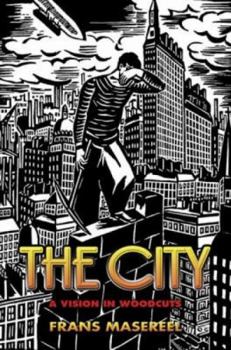The City: A Vision in Woodcuts
Select Format
Select Condition 
Book Overview
"An absolute song for an ongoing visit with timelessness." -- The New York Times
This graphic novel by an Expressionist master offers a stunning depiction of urban Europe between the world wars. First published in Germany in 1925, it presents unforgettable images from the tense and dynamic Weimar period, rendered in 100 woodcuts of remarkable force and beauty.
A pacifist during World War I, Belgian-born Frans Masereel (1889-1972) sympathized...
Format:Paperback
Language:English
ISBN:0486447316
ISBN13:9780486447315
Release Date:March 2006
Publisher:Dover Publications
Length:112 Pages
Weight:0.50 lbs.
Dimensions:0.3" x 6.0" x 9.1"
Customer Reviews
4 ratings
Masterful woodcut artist that predates artist comic style novels
Published by Thriftbooks.com User , 15 years ago
Everything that is in the city is in Masereel's woodcuts: the good, the bad, the ugly...it is all here in powerful images done in woodcut. Masereel's woodcuts translate city life in every aspect,...rich, poor, work, play, night, day, life, and death. The simplicity he uses to convey his message, results in emotionally charged images that feel timeless. These woodcuts were originally done in 1930's, but everything in this books still has a great relative value todays living.
Fascinating snapshot in time
Published by Thriftbooks.com User , 17 years ago
Masereel's work, as one of Will Eisner's inspirations, is an ancestor of the modern graphic novel. That historical insight is a freebie, though. Reading this slim book offers many rewards of much more direct sorts. It's not a graphic novel itself, no matter what some have said about it. Instead of a novel's narrative coherence, this presents a sequence of still images. They relate to each other only loosely and conceptually, not in causal flow. This criticism applies only to how Masereel's work is presented, however, and not to the work itself. That is exceptional. Woodcut may look crude, if your eye isn't attuned to it. Edges are hard; delicacy arises from the subject matter and composition, not from the medium. That works well in this case, since Masereel uses it to document the hard parts of city life between the two world wars. He shows love freely given, but also physical love for hire or taken by force. There is death, violence, and military hardware in the streets. Masereel shows both sides of everything, though: medical students harvest life for others from a woman's cadaver, and a steel mill's torrent of fire reminds the reader of how society's tools and materials are formed. Masereel's visual style tends toward the primitive, despite the city sophistication of his subjects. It works. His primitive lines emphasize the primitive urges of life, love, control, and violence. He fills his visual field with detail. Even though woodcut is a medium of contrasts, many of these prints tend toward a uniform texture and "gray." That sometimes makes it hard to focus on the central points of an image. It also conveys that very urban sense of closeness and distraction, the feeling that everything everywhere is competing for attention, and confusion about what really needs the attention. Dover has recently brought this and similar work (including Lynd Ward's) back into print after decades of obscurity. Perhaps the copyright limit expired and the work has fallen into the public domain. Whatever the reason, it has fallen back into public awareness, too, and I'm glad of it. //wiredweird
Glorious views of the European city
Published by Thriftbooks.com User , 18 years ago
An incredible record of life in Paris, Berlin, and Geneva between the World Wars. Magnificent woodblocks by Belgian artist, a contemporary of Kathe Kollwitz and George Grosz, who fled the Nazis on a 300 mile trek through France, was honored in China, as well as in Europe, and remained a strong supporter of the European youth movement until his death in 1972.
perfect cafe reading to inspire napkin doodling
Published by Thriftbooks.com User , 25 years ago
This pocket size book of woodcuts first published in the 1920's seems remarkably contemporary in its perception of cities, capturing in black and white the crowding, pollution, corruption, poverty, greed, lust, and good times that were as much a part of the urban landscape back then as they are today. New York artist Eric Drooker's work (Flood!, Allen Ginsberg's Illuminated Poems) often reflects Masereel's sensibility, both in its blocky look and subject matter.All the best books are out of print but this one is definitely worth tracking down. Good luck.




